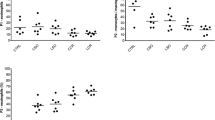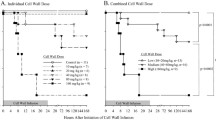Abstract
PURPOSE: We evaluated cell-mediated immune function after laparoscopic-assisted and open bowel resection in rats by measuring delayed-type hypersensitivity responses to keyhole limpet hemocyanin (KLH) and phytohemagglutinin (PHA). METHODS: Male Sprague-Dawley rats (n=120) were sensitized to 1 mg of KLH ten days before investigations. Rats were challenged preoperatively, immediately postoperatively, and on postoperative day (POD) 2 with an intradermal injection of 0.3 mg of KLH and 0.2 mg of PHA (at different sites). Averages of two measures of perpendicular diameters (taken 24 and 48 hours postchallenge) were used to calculate the area of induration using the formula for the area of an ellipse, A=(D1/2×D2/2)×π. Anesthesia control animals underwent no procedure (n=40). Open resection group underwent ligation and resection of the cecum (length=2 cm) through a 7 cm midline incision (n=40). In the laparoscopic-assisted resection group, under CO2 pneumoperitoneum (4–6 mmHg), the cecum was identified, dissected free, and exteriorized through a 4 mm port. The cecum was then ligated and resected extracorporeally (n=40). RESULTS: Preoperative responses to both KLH and PHA were the same in all three groups. Furthermore, within each group, postoperative responses were similar. When groups were compared, the anesthesia group responses were significantly greater than the open resection group responses at all time points (P <0.05 for all comparisons). Laparoscopic-assisted resection group responses differed from control at only two of eight postoperative measures. Laparoscopic resection group responses were significantly greater than open resection group responses to challenge with both KLH and PHA on POD1 (P <0.02, for both comparisons) and POD 4 (P <0.05, for both comparisons). CONCLUSIONS: Postoperative cell-mediated immune function is better preserved after laparoscopic-assisted bowel resection than after open resection as assessed by skin antigen testing.
Similar content being viewed by others
References
Christou NV, Superina R, Broadhead M, Meakins JL. Postoperative depression of host resistance: determinants and effect of peripheral protein-sparing therapy. Surgery 1982;92:786–92.
Hjortso NC, Kehlet H. Influence of surgery, age and serum albumin on delayed hypersensitivity. Acta Chir Scand 1986;152:175–9.
Lennard TW, Shenton BK, Borzotta A,et al. The influence of surgical operations on components of the human immune system. Br J Surg 1985;72:771–6.
Nielsen HJ, Pedersen BK, Moesgaard F, Haahr PM, Kehlet H. Effect of ranitidine on postoperative suppression of natural killer cell activity and delayed hypersensitivity. Acta Chir Scand 1989;155:377–82.
Nielsen HJ, Moesgaard F, Kehlet H. Ranitidine for prevention of postoperative suppression of delayed hypersensitivity. Am J Surg 1989;157:291–4.
Hammer JH, Nielsen HJ, Moesgaard F, Kehlet H. Duration of postoperative immunosuppression assessed by repeated delayed type hypersensitivity skin tests. Eur Surg Res 1992;24:133–7.
Horgan PG, Fitzpatrick M, Course NF,et al. Laparoscopy is less immunotraumatic than laparotomy. Minimal Invasive Ther 1992;1:241–4.
Redmond HP, Watson RW, Houghton T, Condron C, Watson RG, Bouchier-Hayes D. Immune function in patients undergoing open vs laparoscopic cholecystectomy. Arch Surg 1994;129:1240–6.
Trokel MJ, Bessler M, Treat MR, Whelan RL, Nowygrod R. Preservation of immune response after laparoscopy. Surg Endosc 1994;8:1385–8.
Mendenhall CL, Grossman CJ, Roselle GA,et al. Phytohemagglutinin skin test responses to evaluatein vivo cellular immune function in rats. Proc Soc Exp Biol Med 1989;190:117–20.
Abbas AK, Lichtman AH, Pober JS, eds. Cellular and molecular immunology. 2nd ed. Philadelphia: WB Saunders, 1994:262–71.
Tchervenkov JI, Diano E, Meakins JL, Christou NV. Susceptibility to bacterial sepsis: accurate measurement by the delayed-type hypersensitivity skin test score. Arch Surg 1986;121:37–40.
Christou NV, Meakins JL, MacLean LD. The predictive role of delayed hypersensitivity in preoperative patients. Surg Gynecol Obstet 1981;152:297–301.
Eilber FR, Morton DL. Impaired immunologic reactivity and recurrence following cancer surgery. Cancer 1970;25:362–7.
Pietsch JB, Meakins JL, MacLean LD. The delayed hypersensitivity response: application in clinical surgery. Surgery 1977;82:349–55.
Author information
Authors and Affiliations
Additional information
Supported by a grant from the Ethicon Division of Johnson & Johnson Inc., Cincinnati, Ohio.
Read at the meeting of The American Society of Colon and Rectal Surgeons, Seattle, Washington, June 9 to 14, 1996.
About this article
Cite this article
Allendorf, J.D.F., Bessler, M., Whelan, R.L. et al. Better preservation of immune function after laparoscopic-assistedvs. open bowel resection in a murine model. Dis Colon Rectum 39 (Suppl 10), S67–S72 (1996). https://doi.org/10.1007/BF02053809
Issue Date:
DOI: https://doi.org/10.1007/BF02053809




